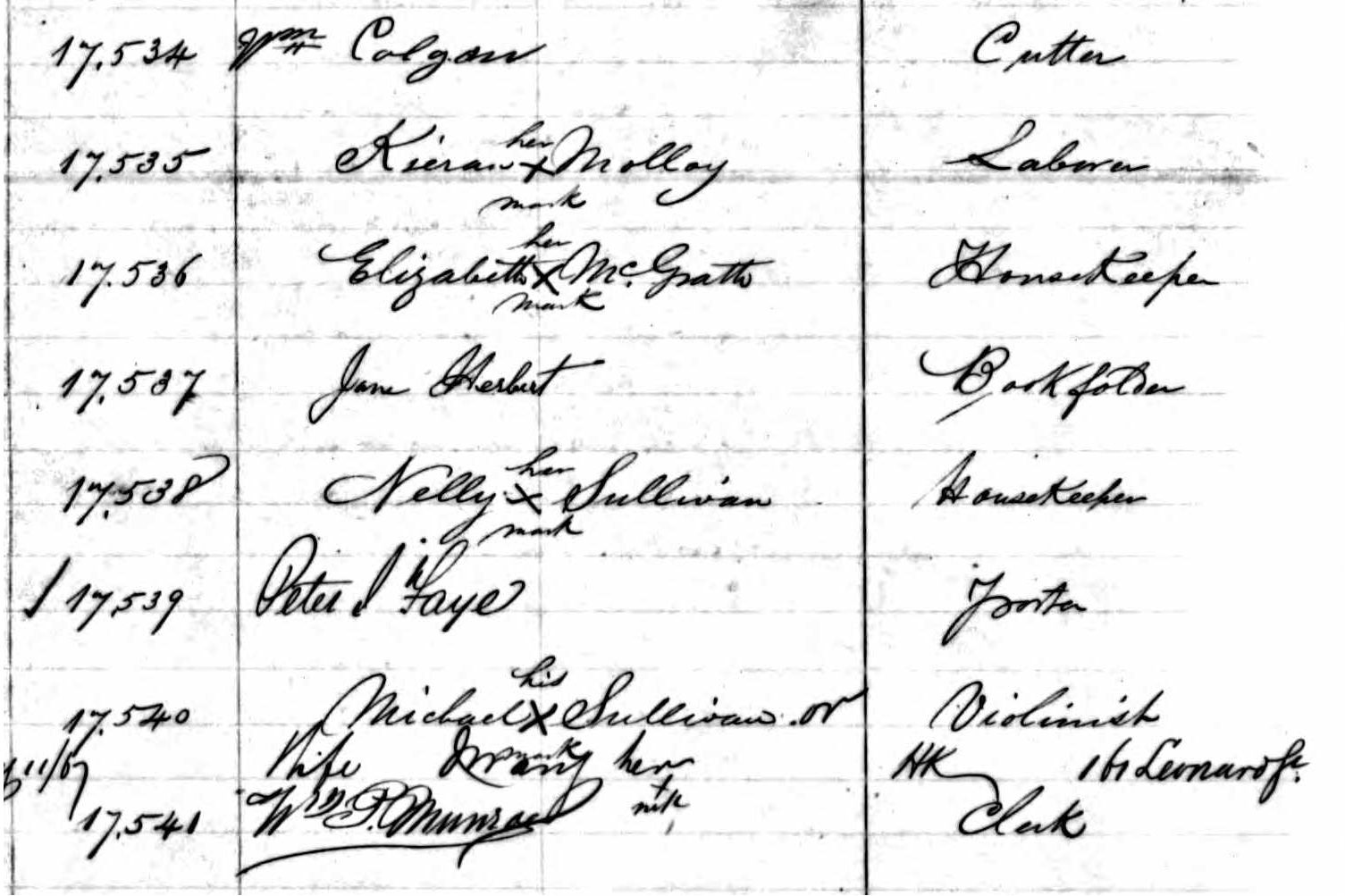By Ruth Steinhardt
Peter Faye was clearly already well educated when he arrived in New York City in 1848 and opened an account at the Emigrant Savings Bank. Few of the million-plus emigrants who left Ireland during the devastating potato famine had a signature as graceful as Mr. Faye’s, which caught the eye of researcher Tyler Anbinder.
“He starts out working as a clerk, which is a pretty high-status job for a famine immigrant,” said Dr. Anbinder, a professor of history at the George Washington University. “But as we track him in the census we find later he becomes a doorkeeper, and that’s his job for 25 years. I thought that was so odd. If you’re that educated, and you have this good job as a clerk, why give it up to become a doorman?”
Then the team found an obituary that answered the question. Peter Faye was indeed a doorman—the one and only at the New York Stock Exchange.
Wealthy and influential members of the exchange turned to Mr. Faye to carry messages, money and packages. He ran confidential errands that involved tracking down members at their homes and clubs, and he passed on information from his own friends and neighbors in parts of the city they didn’t frequent. In exchange, members rewarded him with huge cash gratuities and—perhaps more importantly—“sure thing” stock tips.
“He died a rich man,” Dr. Anbinder said.
Peter Faye’s was only one of hundreds of individual stories to emerge from Dr. Anbinder’s latest project, “Networks and Opportunities: A Digital History of Ireland’s Great Famine Refugees in New York.” The piece was published in the American Historical Review this month, coauthored with Irish economic historian Cormac Ó Gráda, professor emeritus of economics at University College Dublin, and data analyst Simone Wegge, professor of economics at the City University of New York. It tracks the life stories of thousands of individual Irish famine immigrants to New York City, illuminating the connections that allowed some to thrive financially while others did not.
The key, as Peter Faye almost certainly knew, was networking.
Creating a database
Dr. Anbinder was already familiar with the unusually detailed records of the Emigrant Savings Bank, which tracked its account holders’ current addresses, places of origin in Ireland, dates of arrival in the United States and names of immediate and extended family members. He previously had used them to examine the savings habits of individual Irish immigrants, records of whom tend to be minimal, especially from 1845 to 1849 when the famine was at its peak.
“The Irish in the 19th century tended to name their kids after the same six saints and have a limited number of surnames, so it can be hard to distinguish individuals and track down information on them,” Dr. Anbinder said. “But these bank records have enough information to distinguish one from another.”
Dr. Anbinder’s research showed that famine immigrants managed to save more than expected, but he also saw patterns for which he had no explanation. Why did day laborers and unskilled workers save more, on average, than skilled artisans? Within populations of unskilled workers, why did those from Ireland’s County Cork save so much less than those from neighboring County Kerry? And why did people who emigrated from rural Ireland do better financially than those from Irish cities? What, in short, distinguished those who thrived financially from those who did not?
Dr. Anbinder teamed up with economists Dr. Ó Gráda and Dr. Wegge to answer these questions, but he also needed an extensive, searchable database. A $290,000 grant from the National Endowment for the Humanities enabled them to hire about two dozen research assistants, mostly undergraduate students, who spent months deciphering thousands of pages in 19th-century bank clerks’ elegant but archaic handwriting.
The resulting database covered more than 15,000 individuals. With the help of a staff genealogist and using digital humanities resources like Ancestry.com, the team began to trace those individuals’ journeys through neighborhoods, jobs and marriages over the ensuing decades.
Sticking to neighbors, not to jobs
The data suggested that financial success was strongly correlated to maintaining close ties with neighbors from the old country. In the cases of counties Cork and Kerry, for instance, unskilled Kerry emigrants succeeded because they tended to form residential enclaves.
“When people from Kerry got to New York, they stayed pretty close together and lived in the same neighborhoods,” Dr. Anbinder said. “Not only that, but when they moved away, they also moved to the same places.”
These residential enclaves helped neighbors pass on information more easily in an age without telephones. Sharing employment opportunities among neighbors from the same places of origin led, in turn, to occupational niches among unskilled workers. Emigrants from a particular town in Kerry came to dominate the workforce in New York’s gasworks, while the city’s “Morocco dressers,” who tanned classy-looking goatskins for cheap bookbinding, nearly all originated in one part of Ulster.
“Basically somebody from a particular village starts practicing this new trade in New York, and when friends and relatives come they learn how to do that trade too,” Dr. Anbinder said.
Outside of geographical connections, unskilled workers tended to save more because they were more willing to change occupations, Dr. Anbinder said.
“Skilled people stuck to their trade no matter what, because they were very proud of their craft,” Dr. Anbinder said. “Whereas people who weren’t skilled tended to change jobs a lot and would eventually move to something without much status that paid well.”
The study’s findings might help explain the success of Stock Exchange factotum Peter Faye, whose handwriting and early clerking job indicated a high level of education and training. Despite being part of the professional class, Mr. Faye was willing to take a nominally humbler position as a doorman—and then took advantage of the opportunities his new job offered to a man with some charm and hustle.
They also suggested an explanation for the relative financial failure of emigrants from Irish cities as compared to those from rural areas.
“People from urban Ireland tended to be skilled artisans, so that hurts them in terms of upward mobility,” Dr. Anbinder said. “But the other thing we found was that people from urban Ireland never created residential niches. They spread out all over the city.”
A gold mine for students and researchers
While “Networks and Opportunities” is published in AHR’s print edition, it is best read online as an interactive digital work, Dr. Anbinder said.
“One thing I felt strongly about was that, in this day and age, if you read a work of history you should be able to click and see the documents that underpin it,” he said. “When you look at handwritten documents, history really comes alive and becomes much more engaging.”
For Dr. Anbinder, the study is perhaps most valuable as a classroom resource for all educational levels. Some teachers have already started using it as such: Dr. Anbinder sat in on one history class where each student chose an immigrant from his database and presented reports on his or her life story.
“I’m interested in adding a human dimension to the story of potato famine immigrants,” Dr. Anbinder said. “Sometimes that story is told as this kind of monolith of faceless suffering. But these were real people who suffered incredible hardships and their amazing stories deserve to be rediscovered and retold.”



